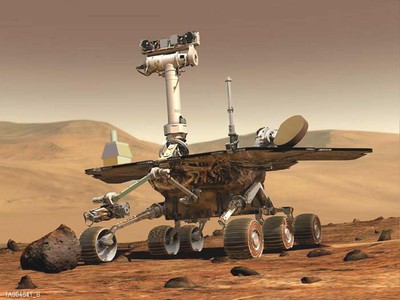




NASA stands for National Aeronautics and Space Administration. NASA is a U.S. government agency that is responsible for science and technology related to air and space. The Space Age started in 1957 with the launch of the Soviet satellite Sputnik. NASA opened for business on Oct. 1, 1958. The agency was created to oversee U.S. space exploration and aeronautics research. The administrator is in charge of NASA. The NASA administrator is nominated by the president and confirmed by a vote in the Senate.
NASA stands for National Aeronautics and Space Administration. NASA is a U.S. government agency that is responsible for science and technology related to air and space. The Space Age started in 1957 with the launch of the Soviet satellite Sputnik. The administrator is in charge of NASA. The NASA administrator is nominated by the president and confirmed by a vote in the Senate.

The Perseverance rover will seek signs of ancient life and collect rock and soil samples for possible return to Earth.


The Perseverance rover has a new, more capable wheel design, among other improvements. For the first time, the rover carries a drill for coring samples from Martian rocks and soil.
Designing A Mars Rover To Launch In 2020
The Mars 2020 rover,Perseverance, is based on the Mars Science Laboratory's Curiosity rover configuration. It is car-sized, about 10 feet long (not including the arm),9 feet wide, and 7 feet tall (about 3 meters long, 2.7 meters wide, and 2.2 meters tall). But at 2,260 pounds (1,025 kilograms.




NASA is most likely the most alluring of all government agencies. Since NASA deals with exploring the unknown and advancing mankind, many people want to work for NASA in some sort of capacity. While becoming an astronaut may be the best known job at NASA, there are many other career and job paths that are critical towards the overall future success of the space program.
(Computer Engineering,Accounting,Administrative Support,Engineering Technician,
Meteorology)
From 1946, the National Advisory Committee for Aeronautics (NACA) had been experimenting with rocket planes such as the supersonic Bell X-1. In the early 1950s, there was a challenge to launch an artificial satellite for the International Geophysical Year (1957–58), resulting in the American Project Vanguard among others. After the Soviet launch of the world's first artificial satellite (Sputnik 1) on October 4, 1957, the attention of the United States turned toward its own fledgling space efforts. The US Congress, alarmed by the perceived threat to national security and technological leadership (known as the "Sputnik crisis"), urged immediate and swift action; President Dwight D. Eisenhower and his advisers counseled more deliberate measures. On January 12, 1958, NACA organized a "Special Committee on Space Technology", headed by Guyford Stever. On January 14, 1958, NACA Director Hugh Dryden published "A National Research Program for Space Technology" stating: It is of great urgency and importance to our country both from consideration of our prestige as a nation as well as military necessity that this challenge [Sputnik] be met by an energetic program of research and development for the conquest of space ... It is accordingly proposed that the scientific research be the responsibility of a national civilian agency ... NACA is capable, by rapid extension and expansion of its effort, of providing leadership in space technology. While this new federal agency would conduct all non-military space activity, the Advanced Research Projects Agency (ARPA) was created in February 1958 to develop space technology for military application. On July 29, 1958, Eisenhower signed the National Aeronautics and Space Act, establishing NASA. When it began operations on October 1, 1958, NASA absorbed the 43-year-old NACA intact; its 8,000 employees, an annual budget of US$100 million, three major research laboratories (Langley Aeronautical Laboratory, Ames Aeronautical Laboratory, and Lewis Flight Propulsion Laboratory) and two small test facilities.A NASA seal was approved by President Eisenhower in 1959. Elements of the Army Ballistic Missile Agency and the United States Naval Research Laboratory were incorporated into NASA. A significant contributor to NASA's entry into the Space Race with the Soviet Union was the technology from the German rocket program led by Wernher von Braun, who was now working for the Army Ballistic Missile Agency (ABMA), which in turn incorporated the technology of American scientist Robert Goddard's earlier works. Earlier research efforts within the US Air Force and many of ARPA's early space programs were also transferred to NASA. In December 1958, NASA gained control of the Jet Propulsion Laboratory, a contractor facility operated by the California Institute of Technology.
The agency's leader, NASA's administrator, is nominated by the President of the United States subject to approval of the US Senate, and reports to him or her and serves as senior space science advisor. Though space exploration is ostensibly non-partisan, the appointee usually is associated with the President's political party (Democratic or Republican), and a new administrator is usually chosen when the Presidency changes parties. The only exceptions to this have been: Democrat Thomas O. Paine, acting administrator under Democrat Lyndon B. Johnson, stayed on while Republican Richard Nixon tried but failed to get one of his own choices to accept the job. Paine was confirmed by the Senate in March 1969 and served through September 1970. Republican James C. Fletcher, appointed by Nixon and confirmed in April 1971, stayed through May 1977 into the term of Democrat Jimmy Carter. Daniel Goldin was appointed by Republican George H. W. Bush and stayed through the entire administration of Democrat Bill Clinton. Robert M. Lightfoot, Jr., associate administrator under Democrat Barack Obama, was kept on as acting administrator by Republican Donald Trump until Trump's own choice Jim Bridenstine, was confirmed in April 2018. The first administrator was Dr. T. Keith Glennan appointed by Republican President Dwight D. Eisenhower. During his term he brought together the disparate projects in American space development research. The second administrator, James E. Webb (1961–1968), appointed by President John F. Kennedy, was a Democrat who first publicly served under President Harry S. Truman. In order to implement the Apollo program to achieve Kennedy's Moon landing goal by the end of the 1960s, Webb directed major management restructuring and facility expansion, establishing the Houston Manned Spacecraft (Johnson) Center and the Florida Launch Operations (Kennedy) Center. Capitalizing on Kennedy's legacy, President Lyndon Johnson kept continuity with the Apollo program by keeping Webb on when he succeeded Kennedy in November 1963. But Webb resigned in October 1968 before Apollo achieved its goal, and Republican President Richard M. Nixon replaced Webb with Republican Thomas O. Paine. James Fletcher was responsible for early planning of the Space Shuttle program during his first term as administrator under President Nixon. He was appointed for a second term as administrator from May 1986 through April 1989 by President Ronald Reagan to help the agency recover from the Space Shuttle Challenger disaster. Former astronaut Charles Bolden served as NASA's twelfth administrator from July 2009 to January 20, 2017. Bolden is one of three former astronauts who became NASA administrators, along with Richard H. Truly (served 1989–1992) and Frederick D. Gregory (acting, 2005). The agency's administration is located at NASA Headquarters in Washington, DC and provides overall guidance and direction. Except under exceptional circumstances, NASA civil service employees are required to be citizens of the United States.
The Apollo program, also known as Project Apollo, was the third United States human spaceflight program carried out by the National Aeronautics and Space Administration (NASA), which succeeded in landing the first humans on the Moon from 1969 to 1972. ... In these six spaceflights, twelve men walked on the Moon.
An astronaut or cosmonaut is a person trained by a human spaceflight program to command, pilot, or serve as a crew member of a spacecraft. Although generally reserved for professional space travelers, the terms are sometimes applied to anyone who travels into space, including scientists, politicians, journalists and tourists
Taking 400-foot 15-second hops, lunar "pogo sticks" could most forward at about 20 miles an hour—much faster than the four to five miles an hour of vehicles now being considered for moon exploration. The moon leaper was devised by Dr. Howard S. Seifert, scientist at the United Technology Center at Sunnyvale, Calif.